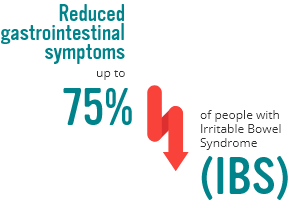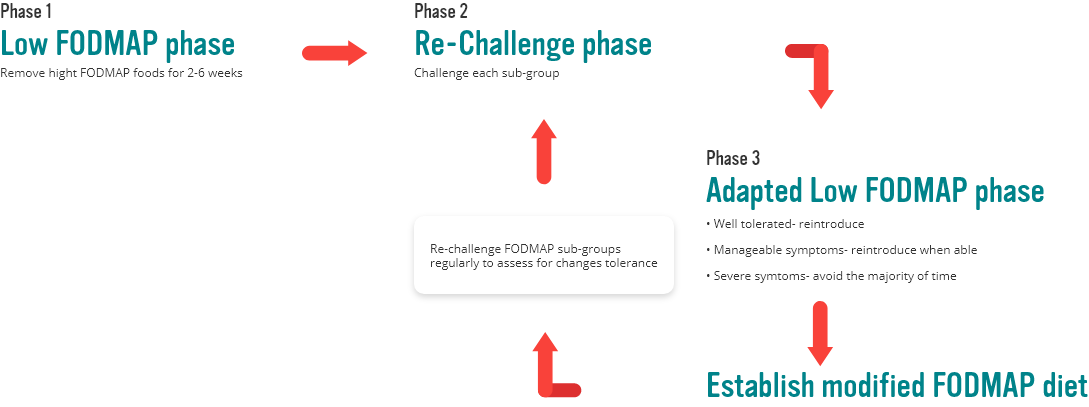What is a Low FODMAP Diet?
The Low FODMAP Diet was developed by researchers at Monash University in Melbourne, Australia. It has now been scientifically proven to significantly reduce gastrointestinal symptoms in up to 75% of people with Irritable Bowel Syndrome (IBS). It works by limiting the foods that are high in FODMAP sugars and are known to be involved in triggering IBS type symptoms. By carefully identifying and reducing FODMAP-rich foods, the diet helps minimise digestive discomfort, offering a personalised approach to managing IBS while maintaining nutritional balance.

Who is the Low FODMAP Diet for?
Approximately 15% of Australians suffer from symptoms of Irritable Bowel Syndrome such as bloating, abdominal pain, excessive wind and altered bowel habits (constipation and/or diarrhoea). The Low FODMAP Diet is now recommended worldwide as the “go to” dietary intervention to identify triggers and manage these symptoms.
The Low FODMAP Diet has been shown to be effective for:
- People who suffer from gastrointestinal symptoms such as bloating, cramping, excess wind or altered bowel habits (constipation and/or diarrhoea).
- People who are in remission from Inflammatory Bowel Diseases (IBD) but have ongoing symptoms.
- People who have abdominal pain related to endometriosis.
How to Implement a Low FODMAP Diet
The Low FODMAP Diet is not a forever diet. It is a tool that is designed to identify the foods that are involved in triggering your symptoms. These foods will be different for everyone. To identify your individual triggers, the Low FODMAP Diet consists of three phases with the end goal being as much variety as possible with as few symptoms as possible.
Phase 1: The low FODMAP phase
The 2-6 week low FODMAP phase is designed to identify if limiting FODMAPs results in a significant and consistent reduction in gastrointestinal symptoms. During this phase, it is important to remove all high FODMAP foods from your diet and replace them with low FODMAP alternatives.
Phase 2: The Challenge Phase
In the Challenge Phase, each FODMAP group is challenged in isolation to identify which ones are the main culprits for your symptoms and which ones are well tolerated. This phase needs to be well structured and Challenge foods need to be chosen carefully to help you get clear results.
Phase 3: The Modified Low FODMAP Diet
In this phase, the information gathered during your Challenge Phase is used to methodically reintroduce the FODMAPs and serving sizes you tolerated well to achieve as much variety as possible without triggering unpleasant gastrointestinal symptoms. This phase is important, as it ensures that your diet is balanced in the long term for optimal health, wellbeing and of course to keep your gut healthy.

What Should I Do Before Starting
the Low FODMAP Diet?
1. See your doctor
Certain serious medical conditions can have identical symptoms to IBS, so it is essential to see your doctor and have these excluded prior to changing your diet.
2. Investigate healthy habits:
- Regular meals and eating slowly
- Getting enough fibre and fluids
- Limiting alcohol, carbonated drinks, coffee or spicy foods
- Managing stress
- Getting enough sleep
3. Consider
If you are willing and able to restrict your diet for a period of time, without compromising your health.
4. See a specialist Registered Dietitian
The Low FODMAP Diet is a complex medical diet and it is recommended to be implemented with the guidance of a Registered Dietitian who can tailor advice to meet your needs.
What Can I Eat on a Low FODMAP Diet?
On a Low FODMAP Diet, you can still enjoy a variety of foods that are less likely to trigger digestive symptoms. These include certain fruits like oranges, grapes, and strawberries; vegetables such as carrots, cucumbers, and potatoes; and a range of proteins including unprocessed meats, fish, and eggs. For dairy, lactose-free products and alternatives like almond milk are suitable. You can also have grains like rice, oats, and low FODMAP bread, as well as some nuts and seeds, including walnuts and peanuts. Keep in mind that portion size matters, and it’s crucial to track your food intake and symptoms to identify what works best for you. For a detailed list of suitable and unsuitable foods, click the button below.








